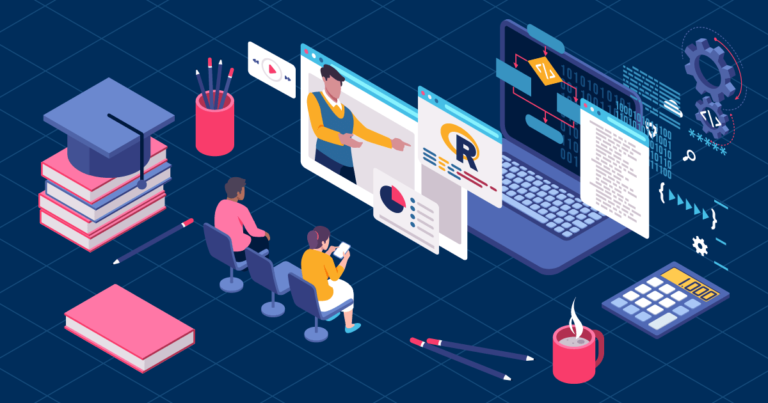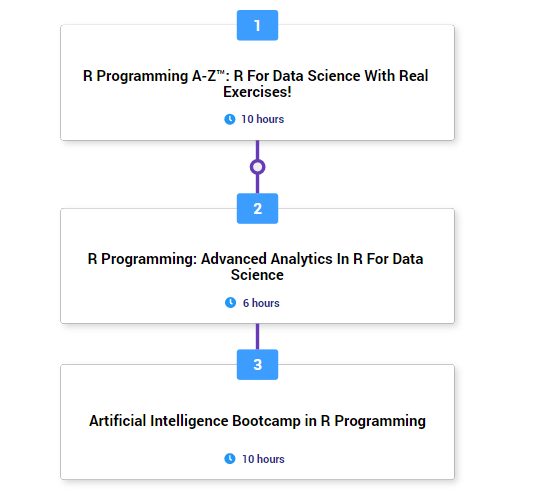7 Tips on How to Learn R in 2 Weeks

In this article, we are going to discuss an important topic for those who are willing to learn R language. R is quite a popular language widely used in data science. If you are new to R, you may have a number of questions such as “What is the best way to learn R?”, “Is it hard to learn R?”. Actually, R is an easy language to learn within a short time period if you are aware of the most efficient ways of R learning.
7 tips for learning R programming for beginners:
- Setup R environment
- Learn basic Syntax
- Learn how R will be useful in data analytics workflow
- Work on R projects
- Watch instructive videos and read related books.
- Take online courses for the R language.
- Experiment and expand R skills
Setup R environment
To learn R programming, you need to work with R. To start things, you have to set up a proper R environment on your local machine. As there can be multiple versions of R, make sure to download the latest version to keep things simple.
R is supported for Windows, Mac OS, and Linux operating systems. If you are a Windows user, please note that R no longer supports Windows XP. Current binary versions of R are known to run on Windows 7 or later.
Installing R on your local machine is a very straightforward task. The simplest way to install R is through CRAN. CRAN stands for Comprehensive R archive network. Here is the link to CRAN, where you can download the latest version of R. The installation can take up to 150MB in disk space.
After installing R, you need to install an integrated development environment (IDE) of R. These IDEs have an improved environment to work with your R scripts. There are several popular IDEs for R, such as Rstudio and Architect. However, if you don’t want to install R on your local machine, you can sign up for RStudio Cloud for free.
Learning basic syntax determines how long to learn R
Learning the basic syntax is the next step to learn R language, as no coding is possible without it. This step is unavoidable, and the time you take for this step heavily determines how long does it take to learn R. The good news is R has one of the simplest syntaxes among programming languages.
Going through RStudio Education is one of the popular ways to learn the basic syntax of the R language. The knowledge base has been split into several categories called beginner, intermediate, and experts targeting readers with different skill levels.
RStudio cloud primers is another great cloud-based resource offered by RStudio to learn the basic syntax of the R language. It is not required to locally set up R in your machine to learn with RStudio cloud premiers. R language cheat sheets is another very helpful reference guide to R syntax for beginners.
Learning basic syntax may not be quite interesting. You don’t need to learn or remember all the syntax mentioned in these resources. However, it is necessary to go through basic syntax and know how to use it. After learning basic syntax, you can improve your coding skills with hands-on experience.
Learn how R will be useful in data analytics workflow
Once you are familiar with basic syntax, the next step is to learn how to use R in a data analytics workflow. Here you have to focus on several important tasks in data analytics workflow.
- Importing data
In R, you can import any type of data format. It takes different approaches to import different data types. For example, you can import data in an excel file using several packages such as the readxl package, the gdata package, and the XLConnect package. But if you are going to import data with a flat file, several functions in util packages can be helpful. Actually, it’s not required to learn how to import data in each and every data format. But it’s important to have a good idea about the data importing techniques that are used frequently.
- Data manipulation
Data manipulation is a wide topic in data analyzing workflow. Several packages can be used for data manipulation in R, such as stringr package, tidyr package, data.table package and lubridate package.
- Data visualization
R has made the data visualization tasks quite easier to handle and implement. You can generate several types of plots in R using several packages such as ggplot2. It is very useful to be familiar with some of the data visualization methods in R.
- Apply statistical methods
In data science workflow, most of the time, there comes situations to apply statistical methods on a given dataset. For that, you need to have a basic knowledge of statistical methods and how we can use those methods in the R language.
The ultimate purpose of learning R is to use it in a data analytics workflow. So the following above steps can be considered as the best way to learn R.
Work on R projects
If you ask an expert about how to learn R programming language, the most common answer is ‘getting hands-on experience’. The best way to get hands-on experience is by working on R projects. Projects allow you to apply what you have learned so far practically, and it will also expose you to problems and questions that you may never face when you learn by reading something. First, it is better to work on structured projects until you get enough experience and then move to create and work on your own projects.
There are plenty of structured R programming projects on the internet. If you get stuck somewhere in your projects, don’t be scared or give up. You are lucky because the R language has a huge active community. You can find solutions simply by browsing the internet or posting questions on Stackoverflow.
By doing your own projects, you can be aware of what areas you need to pay more attention to. You may think about how to get data sets when you do your own projects. Actually, it is very easy. You can find a lot of public datasets on platforms such as Kaggle. You can search and download or import any public dataset there freely.
Applying your creative ideas to these projects and implementing them is one of the best ways to learn R programming.
Watch instructive videos and read best books to learn R
It’s not possible to learn R in a day. But you can certainly learn it in 2 weeks if you follow the right steps. When we want to learn something new, we usually watch related videos or read related books. Obviously, we can use the same method for learning the R programming language as well.
You can find a lot of video tutorials on R on the internet. However, you have to be careful when selecting the videos. If you select an advanced video first, it can make you confused. So make sure that you are watching good and suitable videos to your proficiency level. Google Developers and LearnR are two of the great youtube channels to learn R programming from the beginning.
When considering the best books to learn R, there are many options for you.
- Learning R – This book helps you to learn how to perform data analysis with the R language and its software environment. This book will guide you even if you have little to no programming experience.
- Introduction to Data Science with R – This book will help you learn practical skills to visualize, transform, and model data in R.
- R in a Nutshell – This book provides a quick and practical guide to concepts in R language.
If you want to learn R into more depth, you will need to read more books. Here is a great website that lets you read hundreds of ebooks for free. There, you can find a book for any topic you want to read about.
Take online courses for R language
Taking online courses has become one of the most popular and easiest methods to learn something nowadays. Compared to the traditional courses where you have only one lesson per week, modern courses allow you to access all the lessons at once. This gives you an opportunity to learn R at your own pace, and you know how long to learn R. Also, these courses give you quizzes, assignments that help you to evaluate and practically apply your knowledge.
SDSclub is one of the best places to take online courses on R. They have three courses that can take you from a beginner to an expert in R. The following image illustrates the topics, length, and the order of the three courses. You can see that all three courses can be covered in a few days if you are extremely dedicated to learning R.

These courses require no prerequisites. First, they will teach you the fundamentals like core principles of R programming, how to perform data preparation in R, and how to read data into your R program from different sources. Later they cover things like how to build Artificial Neural Networks in r, and how to build a Convolution Neural Network in R. Thus, taking good online courses is the best way to learn R quickly.
Experiment and expand R skills
Once you are good in syntax and familiar with R concepts, then you can learn and expand R programming knowledge further by experimenting. Since R is an evolving language, new techniques and methods are emerging with R. Couple of them are listed below.
This R package makes it easy to build interactive web apps straight from R. There is a learning portal dedicated to building your Shiny applications.
This helps to run R on the cloud. It’s particularly good for enterprise level applications. There are many advantages to running R on AWS as you get the benefits of the best cloud platform.
However, do not limit yourself to these techniques and tips. As you expand your knowledge, it’s important that you identify common pitfalls in R and how to overcome them.
Summary
This article sums up how to learn R programming fast. R is an exciting language if you know the exact methods on how to learn R. It’s important that you properly set up the R environment before starting programming. Then learn the basic syntax and gradually start doing projects. However, nothing can be as effective as a good online course. That’s why we recommend taking the courses provided by SDSclub as the best option. So with this article, I believe you learn the best way to learn R programming.
If you are looking for more articles on R, subscribe to our newsletter. Feel free to share this article to spread the insight with your friends and colleagues and join the udemy course to learn statistical methods in R quickly.



